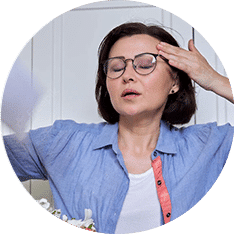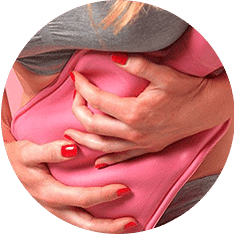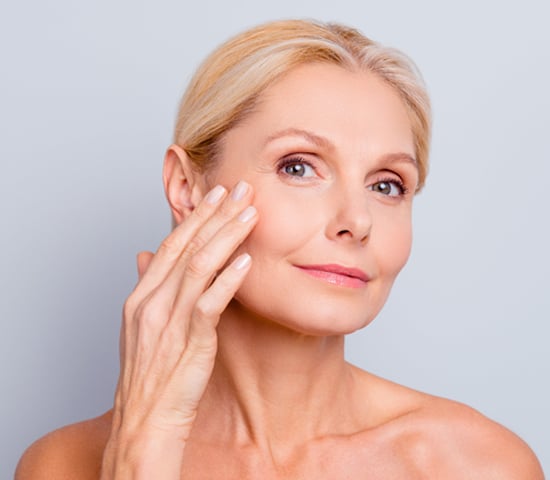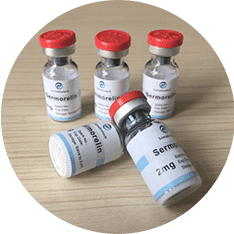
Unlock a More Youthful You With Hormone Replacemment Therapy In Totowa, NJ
Aging is inevitable, and for many, it signals the beginning of a new chapter - one where you cross off bucket list items and live life to the fullest, on your own terms. However, for some women, aging is a horrible prospect, filled with chronic fatigue, irritability, and inability to perform in the bedroom. If you're concerned about life in middle age and beyond, we've got great news: there are easy, proven steps that you can take to help stop the negative effect of aging.
Global Life Rejuvenation was founded to give women a new lease on life - one that includes less body fat, fewer mood swings, and more energy as you age. If you're ready to look and feel younger, it's time to consider HRT (hormone replacement therapy), and growth hormone peptides. These therapies for men and women are effective, safe, and customized to fit your goals, so you can keep loving life as you get older.
HRT, and growth hormone peptide therapies bridge the gap between your old life and the more vibrant, happier version of you. With a simple click or call, you can be well on your way to a brighter future. After all, you deserve to be the one in charge of your wellness and health. Now, you have the tools to do so - backed by science and applied by our team of HRT experts with more than 13 years of experience.
What is HRT?
As women age, their hormones begin to go through changes that affect their day-to-day lives. For women, hormone deficiency and imbalance usually occur during menopause and can cause chronic fatigue, hot flashes, and mood swings, among other issues. Hormone replacement therapy helps correct hormone imbalances in women, helping them feel more vibrant and virile as they age.
Often, HRT treatments give patients enhanced quality of life that they didn't think was possible - even in their 60's and beyond.
The benefits for women are numerous and are available today through Global Life Rejuvenation.
HORMONE REPLACEMENT THERAPY
HRT and Anti-Aging Medicine for Women in Totowa, NJ
As women age, their bodies begin to go through significant changes that affect their quality of life. This change is called menopause and marks the end of a woman's menstrual cycle and reproduction ability. Though there is no specific age when this change occurs, the average age of menopause onset is 51 years old. However, according to doctors, menopause officially starts 12 months after a woman's final period. During the transition to menopause, women's estrogen and other hormones begin to deplete.
As that happens, many women experience severe symptoms. These symptoms include:
- Hot Flashes
- Chronic Fatigue
- Incontinence
- Trouble Sleeping
- Dryness
- Muscle Loss
- Fat Gain
- Mood Swings
The symptoms of hormone deficiency can be concerning and scary for both women and their spouses. However, if you're getting older and notice some of these symptoms, there is reason to be hopeful. Hormone replacement therapy and anti-aging medicine for women can correct imbalances that happen during menopause. These safe, effective treatments leave you feeling younger, healthier, and more vibrant.


What Causes Menopause?
The most common reason for menopause is the natural decline in a female's reproductive hormones. However, menopause can also result from the following situations:
Oophorectomy: This surgery, which removes a woman's ovaries, causes immediate menopause. Symptoms and signs of menopause in this situation can be severe, as the hormonal changes happen abruptly.
Chemotherapy: Cancer treatments like chemotherapy can induce menopause quickly, causing symptoms to appear shortly after or even during treatment.
Ovarian Insufficiency: Also called premature ovarian failure, this condition is essentially premature menopause. It happens when a woman's ovaries quit functioning before the age of 40 and can stem from genetic factors and disease. Only 1% of women suffer from premature menopause, but HRT can help protect the heart, brain, and bones.
Common Issues for Women During Menopause
For many women, menopause is a trying time that can be filled with many hormonal hurdles to jump through. A little knowledge can go a long way, whether you're going through menopause now or are approaching "that" age.
Here are some of the most common issues that women experience during menopause:

Depression
If you're a woman going through menopause and find that you have become increasingly depressed, you're not alone. It's estimated that 15% of women experience depression to some degree while going through menopause. What many women don't know is that depression can start during perimenopause, or the years leading up to menopause.
Depression can be hard to diagnose, especially during perimenopause and menopause. However, if you notice the following signs, it might be time to speak with a physician:
- Mood Swings
- Inappropriate Guilt
- Chronic Fatigue
- Too Much or Too Little Sleep
- Lack of Interest in Life
- Overwhelming Feelings
Remember, if you're experiencing depression, you're not weak or broken - you're going through a very regular emotional experience. The good news is that with proper treatment from your doctor, depression isn't a death sentence. And with HRT and anti-aging treatment for women, depression could be the catalyst you need to enjoy a new lease on life.

Hot Flashes
Hot flashes - they're one of the most well-known symptoms of menopause. Hot flashes are intense, sudden feelings of heat across a woman's upper body. Some last second, while others last minutes, making them incredibly inconvenient and uncomfortable for most women.
Symptoms of hot flashes include:
- Sudden, Overwhelming Feeling of Heat
- Anxiety
- High Heart Rate
- Headache
- Nausea
- Dizziness
Typically, hot flashes are caused by a lack of estrogen. Low estrogen levels negatively affect a woman's hypothalamus, the part of the brain that controls body temperature and appetite. Low estrogen levels cause the hypothalamus to incorrectly assume the body is too hot, dilating blood vessels to increase blood flow. Luckily, most women don't have to settle for the uncomfortable feelings that hot flashes cause. HRT treatments for women often stabilize hormones, lessening the effects of hot flashes and menopause in general.

Mood Swings
Mood swings are common occurrences for most people - quick shifts from happy to angry and back again, triggered by a specific event. And while many people experience mood swings, they are particularly common for women going through menopause. That's because, during menopause, the female's hormones are often imbalanced. Hormone imbalances and mood swings go hand-in-hand, resulting in frequent mood changes and even symptoms like insomnia.
The rate of production of estrogen, a hormone that fluctuates during menopause, largely determines the rate of production the hormone serotonin, which regulates mood, causing mood swings.
Luckily, HRT and anti-aging treatments in Totowa, NJ for women work wonders for mood swings by regulating hormone levels like estrogen. With normal hormone levels, women around the world are now learning that they don't have to settle for mood swings during menopause.

Weight Gain
Staying fit and healthy is hard for anyone living in modern America. However, for women with hormone imbalances during perimenopause or menopause, weight gain is even more serious. Luckily, HRT treatments for women coupled with a physician-led diet can help keep weight in check. But which hormones need to be regulated?
- Estrogen: During menopause, estrogen levels are depleted. As such, the body must search for other sources of estrogen. Because estrogen is stored in fat, your body believes it should increase fat production during menopause. Estrogen also plays a big part in insulin resistance, which can make it even harder to lose weight and keep it off.
- Progesterone: Progesterone levels are also depleted during menopause. Progesterone depletion causes bloating and water retention, while loss of testosterone limits the body's ability to burn calories.
- Ongoing Stress: Stress makes our bodies think that food is hard to come by, putting our bodies in "survival mode". When this happens, cortisol production is altered. When cortisol timing changes, the energy in the bloodstream is diverted toward making fat. With chronic stress, this process repeatedly happens, causing extensive weight gain during menopause.

Low Libido
Lowered sexual desire - three words most men and women hate to hear. Unfortunately, for many women in perimenopausal and menopausal states, it's just a reality of life. Thankfully, today, HRT and anti-aging treatments Totowa, NJ can help women maintain a normal, healthy sex drive. But what causes low libido in women, especially as they get older?
The hormones responsible for low libido in women are progesterone, estrogen, and testosterone.
Progesterone production decreases during perimenopause, causing low sex drive in women. Lower progesterone production can also cause chronic fatigue, weight gain, and other symptoms. On the other hand, lower estrogen levels during menopause lead to vaginal dryness and even vaginal atrophy or loss of muscle tension.
Lastly, testosterone plays a role in lowered libido. And while testosterone is often grouped as a male hormone, it contributes to important health and regulatory functionality in women. A woman's testosterone serves to heighten sexual responses and enhances orgasms. When the ovaries are unable to produce sufficient levels of testosterone, it often results in a lowered sex drive.

Vaginal Dryness
Often uncomfortable and even painful, vaginal dryness is a serious problem for sexually active women. However, like hair loss in males, vaginal dryness is very common - almost 50% of women suffer from it during menopause.
Getting older is just a part of life, but that doesn't mean you have to settle for the side effects. HRT and anti-aging treatments for women correct vaginal dryness by re-balancing estrogen, progesterone, and testosterone. When supplemented with diet and healthy living, your vagina's secretions are normalized, causing discomfort to recede.

Fibroids
Uterine fibroids - they're perhaps the least-known symptom of menopause and hormone imbalances in women. That's because these growths on the uterus are often symptom-free. Unfortunately, these growths can be cancerous, presenting a danger for women as they age.
Many women will have fibroids at some point. Because they're symptomless, they're usually found during routine doctor exams. Some women only get one or two, while others may have large clusters of fibroids. Because fibroids are usually caused by hormone imbalances, hysterectomies have been used as a solution, forcing women into early menopause.
Advances in HRT and anti-aging medicine for women give females a safer, non-surgical option without having to experience menopause early. At Global Life Rejuvenation, our expert physicians will implement a customized HRT program to stabilize your hormones and reduce the risk of cancerous fibroid growth.

Endometriosis
Endometriosis symptoms are much like the effects of PMS, and include pelvic pain, fatigue, cramping, and bloating. While doctors aren't entirely sure what causes this painful, uncomfortable condition, most agree that hormones - particularly xenoestrogens - play a factor.
Endometriosis symptoms are much like the effects of PMS and include pelvic pain, fatigue, cramping, and bloating. While doctors aren't entirely sure what causes this painful, uncomfortable condition, most agree that hormones - particularly xenoestrogens - play a factor.
Xenoestrogen is a hormone that is very similar to estrogen. Too much xenoestrogen is thought to stimulate endometrial tissue growth. HRT for women helps balance these hormones and, when used with a custom nutrition program, can provide relief for women across the U.S.
Is HRT for Women the Right Answer?
Hormone stability is imperative for a healthy sex drive and for a normal, stress-free life during menopause. HRT and anti-aging treatments for women balance the hormones that your body has altered due to perimenopause or menopause.
HRT for women is a revolutionary step in helping women live their best lives, even as they grow older. However, at Global Life Rejuvenation, we know that no two patients are the same. That's why we specialize in holistic treatments that utilize HRT, combined with healthy nutrition, supplements, and fitness plans that maximize hormone replacement treatments.
If you've been suffering through menopause, is HRT the answer? That's hard to say without an examination by a trusted physician, but one thing's for sure. When a woman balances her hormone levels, she has a much better shot at living a regular life with limited depression, weight gain, mood swings, and hot flashes.
Here are just a few additional benefits of HRT and anti-aging treatments for females:


Benefits of HRT and Anti-Aging Medicine for Women in Totowa, NJ
Hormone imbalance causes a litany of issues. But with anti-aging treatments for women, females can better process calcium, keep their cholesterol levels safe, and maintain a healthy vagina. By replenishing the body's estrogen supply, HRT can relieve symptoms from menopause and protect against osteoporosis. But that's just the start.
Global Life Rejuvenation's patients report many more benefits of HRT and anti-aging medicine for women:
- Fewer Mood Swings
- Thicker Hair
- Stronger Bones
- Less Body Fat
- More Energy
- More Stamina
- Increased Sex Drive and Pleasure Sensations
- Better Cognitive Functions
- Improved Pain Receptors
- Less Hot Flashes and Night Sweats
- Lower Triglycerides
- Fewer Bladder Infections
If you're ready to feel better, look better, and recapture the vitality of your youth, it's time to contact Global Life Rejuvenation. It all starts with an in-depth consultation, where we will determine if HRT and anti-aging treatments for women are right for you. After all, every patient's body and hormone levels are different. Since all our treatment options are personalized, we do not have a single threshold for treatment. Instead, we look at our patient's hormone levels and analyze them on a case-by-case basis.

HRT from Global Life Rejuvenation
At Global Life Rejuvenation, we help women rediscover their youth with HRT treatment for women. We like to think of ourselves as an anti-aging concierge service, guiding and connecting our patients to the most qualified HRT physicians available. With customized HRT treatment plan for women, our patients experience fewer menopausal symptoms, less perimenopause & menopause depression, and often enjoy a more youth-like appearance.
Reverse Aging with Growth Hormone Peptides
Growth hormone peptides are an innovative therapy that boosts the natural human growth hormone production in a person's body. These exciting treatment options help slow down the aging process and give you a chance at restoring your youth.

What is Sermorelin?
Sermorelin is a synthetic hormone peptide, like GHRH, which triggers the release of growth hormones. When used under the care of a qualified physician, Sermorelin can help you lose weight, increase your energy levels, and help you feel much younger.

Benefits of Sermorelin
Human growth hormone (HGH) therapy has been used for years to treat hormone deficiencies. Unlike HGH, which directly replaces declining human growth hormone levels, Sermorelin addresses the underlying cause of decreased HGH, stimulating the pituitary gland naturally. This approach keeps the mechanisms of growth hormone production active.
- Benefits of Sermorelin include:
- Better Immune Function
- Improved Physical Performance
- More Growth Hormone Production
- Less Body Fat
- Build More Lean Muscle
- Better Sleep

What is Ipamorelin?
Ipamorelin helps to release growth hormones in a person's body by mimicking a peptide called ghrelin. Ghrelin is one of three hormones which work together to regulate the growth hormone levels released by the pituitary gland. Because Ipamorelin stimulates the body to produce growth hormone, your body won't stop its natural growth hormone production, which occurs with synthetic HGH.
Ipamorelin causes growth hormone secretion that resembles natural release patterns rather than being constantly elevated from HGH. Because ipamorelin stimulates the natural production of growth hormone, our patients can use this treatment long-term with fewer health risks.

Benefits of Ipamorelin
One of the biggest benefits of Ipamorelin is that it provides significant short and long-term benefits in age management therapies. Ipamorelin can boost a patient's overall health, wellbeing, and outlook on life.
When there is an increased concentration of growth hormone by the pituitary gland, there are positive benefits to the body. Some benefits include:
- Powerful Anti-Aging Properties
- More Muscle Mass
- Less Unsightly Body Fat
- Deep, Restful Sleep
- Increased Athletic Performance
- More Energy
- Less Recovery Time for Training Sessions and Injuries
- Enhanced Overall Wellness and Health
- No Significant Increase in Cortisol
Your New, Youthful Lease on Life with HRT for Women
Whether you are considering our HRT and anti-aging treatments for women in Totowa, NJ, we are here to help. The first step to reclaiming your life begins by contacting Global Life Rejuvenation. Our friendly, knowledgeable HRT experts can help answer your questions and walk you through our procedures. From there, we'll figure out which treatments are right for you. Before you know it, you'll be well on your way to looking and feeling better than you have in years!
 866-793-9933
866-793-9933
Request a Consultation
Latest News in Totowa, NJ
Holiday Parade of Lights to Illuminate Totowa, Woodland Park, and Little Falls
TAPintohttps://www.tapinto.net/towns/passaic-valley/sections/arts-and-entertainment/articles/holiday-parade-of-lights-to-illuminate-totowa-woodland-park-and-little-falls
PASSAIC VALLEY, NJ - The Boroughs of Totowa, Woodland Park, and Little Falls are gearing up for the much-anticipated Totowa, West Paterson, Little Falls Fire Department Holiday Parade of Lights.The holiday festival in Woodland Park is set to dazzle along McBride Avenue from 1 to 4:30 p.m., and promises an array of delights for all ages. Visitors can indulge in a variety of activities, entertainment, and delicious bites from numerous vendors. The event boasts live performances, food trucks, DJ music, and a medley of ac...
PASSAIC VALLEY, NJ - The Boroughs of Totowa, Woodland Park, and Little Falls are gearing up for the much-anticipated Totowa, West Paterson, Little Falls Fire Department Holiday Parade of Lights.
The holiday festival in Woodland Park is set to dazzle along McBride Avenue from 1 to 4:30 p.m., and promises an array of delights for all ages. Visitors can indulge in a variety of activities, entertainment, and delicious bites from numerous vendors. The event boasts live performances, food trucks, DJ music, and a medley of activities tailored for kids. A highlight includes horse and carriage rides from 2 to 5 p.m. and an outdoor ice skating rink open from 1 to 5 p.m.
To usher in the holiday spirit, the Memorial Middle School band will take the stage with live music around 4:30 p.m. just before the grand tree lighting at 4:45 p.m. Welcoming the jolly season, Santa Claus will join the festivity, leading the tree lighting before meeting children at Dowling Gardens.
Sign Up for FREE Passaic Valley Newsletter
Get local news you can trust in your inbox.
This site is protected by reCAPTCHA and the Google Privacy Policy and Terms of Service apply.
The highlight of the day, the Holiday Parade of Lights, will embark from Passaic Valley High School at 5 p.m., traversing through Totowa, Woodland Park, and Little Falls. Over 100 elaborately adorned vehicles and floats will delight onlookers along the route.
One tradition continues as elves stationed along the parade route collect toys for Hackensack Meridian Health, St. Joseph's University Hospital in Paterson, Joseph M. Sanzari Children’s Hospital, and underprivileged families within the community. Donations of unwrapped, new toys can be brought to the parade to spread the holiday cheer.
Woodland Park is also collecting gift cards in any denomination to support those in need. Residents can contribute by placing the gift cards in the designated big red mailbox at the clock tower in Dowling Gardens during the event.
Residents and visitors are advised to expect road closures along the parade route starting around 4 p.m., until approximately 8:00 p.m.
Spectators are encouraged to park in neighborhoods along the route, as well as at 1225 McBride Ave. and the Park West Meadows Shopping Plaza if in Woodland Park. For Little Falls residents, no vehicles will be allowed in or out of the parade area or sections of the Township within the parade route. This includes Main Street between Browertown Road and First Ave, as well as Hopson Ave, Turnberry Road, Tulip Crescent, Van Ness Ave, Sindle Ave, Paterson Ave, and the Entire Jackson Park section of town (including all the side streets in these areas).
As the parade route extends from Totowa Road, running from Hillary Street to Union Boulevard, concluding officially at Crew Street, several streets will undergo closures for parking and traffic management. To alleviate congestion along local streets, organizers encourage attendees to carpool.
The festival will feature a vibrant array of vendors offering an eclectic mix of products, including ornaments, jewelry, candles, photography, pet accessories, and much more.
Can nuns be saved from extinction? Totowa's Little Sisters of the Poor is latest casualty
Deena Yellinhttps://www.northjersey.com/story/news/local/2023/09/26/little-sisters-of-the-poor-leave-nj-as-nuns-face-declining-numbers/70437730007/
5-minute readThis summer, the Little Sisters of the Poor had to admit the sad truth: Their congregation of Roman Catholic sisters, dedicated to helping the elderly, has been shrinking for years. In July, they announced they could no longer staff St. Joseph's Home for the Elderly, the Totowa nursing home where they had cared for thous...
5-minute read
This summer, the Little Sisters of the Poor had to admit the sad truth: Their congregation of Roman Catholic sisters, dedicated to helping the elderly, has been shrinking for years. In July, they announced they could no longer staff St. Joseph's Home for the Elderly, the Totowa nursing home where they had cared for thousands of residents over the last half-century.
The Little Sisters are proud of their long legacy in North Jersey: They began serving the community in 1878, when the order established a home for the elderly on South Eighth Street in Newark that later moved to Dey Street in Paterson. In 1976, they opened St. Joseph's, where a rotating cast of 30 nuns were known for their warmth and selfless care.
In the congregation's heyday in the 1960s, about 5,000 women were members of the Little Sisters of the Poor worldwide. Today, that number has declined to about 1,800, said the Rev. Mark Cregan, an attorney for the order. About 300 remain in the U.S.
Some orders − like the Sisters of Charity of New York, the first U.S. congregation of religious sisters − have stopped accepting new members altogether. Founded in 1817, the community of Roman Catholic women voted in April to begin a "path to completion" after going more than 20 years without successfully recruiting any new entrants.
In July, Mother Alice Marie Monica, provincial superior of the Little Sisters of the Poor said the nuns would withdraw from St. Joseph's, joining the trend of orders around the world that have struggled with dwindling membership.
"After being in New Jersey for 145 years, it is very hard for us Little Sisters to imagine that we will not be serving here in the future," Monica said, adding that the sisters' departure from the home is "a process that has been advancing over the past several years,"
When full, St. Joseph's was home to as many as 250 residents. But as staffing issues have mounted, the census has fallen. By November, the roughly 50 residents still living at the home on Shepherds Lane will move to other senior living facilities, including homes operated by the Little Sisters in other locations.
After that, the Little Sisters will seek a partner to transfer the land and buildings, the Diocese of Paterson said in a statement.
Kevin Sweeney, the bishop of the Diocese of Paterson said he was grateful for their service. "The care of the Little Sisters for the residents for almost a century and a half in our area, following in the line of Saint Jeanne Jugan, has placed love at the heart of their home. The Little Sisters have taught us to be rooted in faith and joyfulness and will ever have our gratitude."
Around the country, other congregations have made similar calculations. With the nun population shrinking, convents are closing or merging − and charities they staffed and supported have closed with them or transitioned to new management.
Will nuns go extinct? The numbers don't look good
In 1966, there were over 180,000 nuns in America. During that era, nuns played a vital role in Catholic schools, orphanages, and senior homes. But interest in the vocation has been waning for decades and today there are fewer than 35,000, according to the Center for Applied Research in the Apostolate at Georgetown University (CARA), which studies the Catholic Church.
Many of today's nuns are over 70 and few young women are replacing those who retire or pass away.
At one time, being a nun was a popular career choice for young Catholic women who wanted to teach, work in a hospital or help the poor − and who were shut out of other professions in a male-dominated society. But these days, with an array of career options available, vows of poverty, chastity and obedience don't seem to hold as much allure.
Sisterly love:Caldwell nuns have lived for a century and been friends nearly as long
"It used to be a badge of honor to have sons who were priests and daughters who were nuns," said Margaret McGuiness, a professor of religion at La Salle University in Philadelphia.
In the mid 1960s, nuns began to reexamine their missions, and many decided they didn't want to be limited to teaching or to wearing the habit, she said. "Sisters in some congregations began going out into the community and doing other types of work involving issues of social justice and advocacy." As a result, more Catholic women left religious life and fewer entered, she said.
Local orders closing down
The Monastery of the Dominican Nuns of the Perpetual Rosary in Camden closed in 2013, while the Sisters of Sorrowful Mother closed St. Francis Residential Community in Denville in 2021 and sold their property to a nonprofit healthcare company. The sprawling brick complex was demolished at the end of last year to make way for a more modern senior living complex.
Just to the south in Morris County, the former St. Ann Villa in Florham Park, long a home to aging Sisters of Charity, was also closed, the Diocese of Paterson announced in 2021. The nursing home, founded in 1930, was transferred in 2016 to Lutheran Social Ministries of New Jersey in a last-ditch attempt to keep it open.
In New York, the Sisters Servants of Mary in the Bronx, which has served the sick for nearly a century, is also closing its doors. At its height, the convent had around 30 sisters who visited and cared for the sick. But that number had dwindled to just three as of June.
A trickle of interest may keep religious orders going
The Sisters of Charity − an order founded by Elizabeth Ann Seton, the first U.S.-born Catholic saint − announced it would close to new members after deciding it no longer had the capacity to carry out its ministries or train newcomers, known as vocations. The order boasted of more than 1,300 nuns in the 1960s but its ranks had diminished to 154 as of April.
Polls show that young people today don't feel the same draw to religion as their parents and grandparents did. The media is replete with articles − from the the New York Times to Fox News - warning that nuns may be headed toward extinction.
But Mark Gray, a senior research associate at CARA, said that nuns won't disappear. Although their ranks are declining, congregations of sisters continue to draw new blood, albeit it in smaller numbers than before, he said. In 2021, 136 women in the U.S. entered religious life, he said, and between 2015 and 2021, 1279 women became nuns.
He attributed the steep decline to a period of "extraordinary growth in the Catholic Church in 1965 when the number of sisters peaked. That was far from the historical norm and the church received decades of service from these women." After that point, new entries slowed, he said.
More:A NJ pastor's coming-of-age tale about young priests makes its big-screen debut
A Gen X sister: 'We are not afraid for our future'
Sister Susan Francois of the Congregation of the Sisters St. Joseph of Peace in Englewood Cliffs, a 51-year-old self-described "Generation X Catholic Sister," said that while large orders may be a thing of the past, "that doesn't mean religious life is going away."
"When I entered the congregation in 2005, most of the sisters were 30 or 40 years older than me," she said. "But I felt like this community was a gift. It was a group of women of all ages and cultures who share the common desire to promote peace, which is our congregation's mission. I can't explain the difference it's made in my life, knowing that you are not alone. There's so much isolation in the world. I always have my sisters. We are committed to each other for life."
Although the congregation is unable to replace all its older members as they age, it is actively inviting new members, and small numbers of young women are responding. Two young women in their 20s are scheduled to join later this month, Francois said.
"We are not afraid for our future."
Correction: A prior version of this story incorrectly said the Sisters of Charity of New York founded the College of St. Elizabeth in Morris County. The college was in fact founded by a different order, the Sisters of Charity of St. Elizabeth. While the Sisters of Charity of New York has voted to stop taking new members, the Morris County order is "alive and well," a spokeswoman said on Tuesday.
Deena Yellin covers religion for NorthJersey.com. For unlimited access to her work covering how the spiritual intersects with our daily lives, please subscribe or activate your digital account today.
Email: [email protected]
Can nuns be saved from extinction? Totowa's Little Sisters of the Poor is latest casualty
Deena Yellinhttps://www.northjersey.com/story/news/local/2023/09/26/little-sisters-of-the-poor-leave-nj-as-nuns-face-declining-numbers/70437730007/
5-minute readThis summer, the Little Sisters of the Poor had to admit the sad truth: Their congregation of Roman Catholic sisters, dedicated to helping the elderly, has been shrinking for years. In July, they announced they could no longer staff St. Joseph's Home for the Elderly, the Totowa nursing home where they had cared for thous...
5-minute read
This summer, the Little Sisters of the Poor had to admit the sad truth: Their congregation of Roman Catholic sisters, dedicated to helping the elderly, has been shrinking for years. In July, they announced they could no longer staff St. Joseph's Home for the Elderly, the Totowa nursing home where they had cared for thousands of residents over the last half-century.
The Little Sisters are proud of their long legacy in North Jersey: They began serving the community in 1878, when the order established a home for the elderly on South Eighth Street in Newark that later moved to Dey Street in Paterson. In 1976, they opened St. Joseph's, where a rotating cast of 30 nuns were known for their warmth and selfless care.
In the congregation's heyday in the 1960s, about 5,000 women were members of the Little Sisters of the Poor worldwide. Today, that number has declined to about 1,800, said the Rev. Mark Cregan, an attorney for the order. About 300 remain in the U.S.
Some orders − like the Sisters of Charity of New York, the first U.S. congregation of religious sisters − have stopped accepting new members altogether. Founded in 1817, the community of Roman Catholic women voted in April to begin a "path to completion" after going more than 20 years without successfully recruiting any new entrants.
In July, Mother Alice Marie Monica, provincial superior of the Little Sisters of the Poor said the nuns would withdraw from St. Joseph's, joining the trend of orders around the world that have struggled with dwindling membership.
"After being in New Jersey for 145 years, it is very hard for us Little Sisters to imagine that we will not be serving here in the future," Monica said, adding that the sisters' departure from the home is "a process that has been advancing over the past several years,"
When full, St. Joseph's was home to as many as 250 residents. But as staffing issues have mounted, the census has fallen. By November, the roughly 50 residents still living at the home on Shepherds Lane will move to other senior living facilities, including homes operated by the Little Sisters in other locations.
After that, the Little Sisters will seek a partner to transfer the land and buildings, the Diocese of Paterson said in a statement.
Kevin Sweeney, the bishop of the Diocese of Paterson said he was grateful for their service. "The care of the Little Sisters for the residents for almost a century and a half in our area, following in the line of Saint Jeanne Jugan, has placed love at the heart of their home. The Little Sisters have taught us to be rooted in faith and joyfulness and will ever have our gratitude."
Around the country, other congregations have made similar calculations. With the nun population shrinking, convents are closing or merging − and charities they staffed and supported have closed with them or transitioned to new management.
Will nuns go extinct? The numbers don't look good
In 1966, there were over 180,000 nuns in America. During that era, nuns played a vital role in Catholic schools, orphanages, and senior homes. But interest in the vocation has been waning for decades and today there are fewer than 35,000, according to the Center for Applied Research in the Apostolate at Georgetown University (CARA), which studies the Catholic Church.
Many of today's nuns are over 70 and few young women are replacing those who retire or pass away.
At one time, being a nun was a popular career choice for young Catholic women who wanted to teach, work in a hospital or help the poor − and who were shut out of other professions in a male-dominated society. But these days, with an array of career options available, vows of poverty, chastity and obedience don't seem to hold as much allure.
Sisterly love:Caldwell nuns have lived for a century and been friends nearly as long
"It used to be a badge of honor to have sons who were priests and daughters who were nuns," said Margaret McGuiness, a professor of religion at La Salle University in Philadelphia.
In the mid 1960s, nuns began to reexamine their missions, and many decided they didn't want to be limited to teaching or to wearing the habit, she said. "Sisters in some congregations began going out into the community and doing other types of work involving issues of social justice and advocacy." As a result, more Catholic women left religious life and fewer entered, she said.
Local orders closing down
The Monastery of the Dominican Nuns of the Perpetual Rosary in Camden closed in 2013, while the Sisters of Sorrowful Mother closed St. Francis Residential Community in Denville in 2021 and sold their property to a nonprofit healthcare company. The sprawling brick complex was demolished at the end of last year to make way for a more modern senior living complex.
Just to the south in Morris County, the former St. Ann Villa in Florham Park, long a home to aging Sisters of Charity, was also closed, the Diocese of Paterson announced in 2021. The nursing home, founded in 1930, was transferred in 2016 to Lutheran Social Ministries of New Jersey in a last-ditch attempt to keep it open.
In New York, the Sisters Servants of Mary in the Bronx, which has served the sick for nearly a century, is also closing its doors. At its height, the convent had around 30 sisters who visited and cared for the sick. But that number had dwindled to just three as of June.
A trickle of interest may keep religious orders going
The Sisters of Charity − an order founded by Elizabeth Ann Seton, the first U.S.-born Catholic saint − announced it would close to new members after deciding it no longer had the capacity to carry out its ministries or train newcomers, known as vocations. The order boasted of more than 1,300 nuns in the 1960s but its ranks had diminished to 154 as of April.
Polls show that young people today don't feel the same draw to religion as their parents and grandparents did. The media is replete with articles − from the the New York Times to Fox News - warning that nuns may be headed toward extinction.
But Mark Gray, a senior research associate at CARA, said that nuns won't disappear. Although their ranks are declining, congregations of sisters continue to draw new blood, albeit it in smaller numbers than before, he said. In 2021, 136 women in the U.S. entered religious life, he said, and between 2015 and 2021, 1279 women became nuns.
He attributed the steep decline to a period of "extraordinary growth in the Catholic Church in 1965 when the number of sisters peaked. That was far from the historical norm and the church received decades of service from these women." After that point, new entries slowed, he said.
More:A NJ pastor's coming-of-age tale about young priests makes its big-screen debut
A Gen X sister: 'We are not afraid for our future'
Sister Susan Francois of the Congregation of the Sisters St. Joseph of Peace in Englewood Cliffs, a 51-year-old self-described "Generation X Catholic Sister," said that while large orders may be a thing of the past, "that doesn't mean religious life is going away."
"When I entered the congregation in 2005, most of the sisters were 30 or 40 years older than me," she said. "But I felt like this community was a gift. It was a group of women of all ages and cultures who share the common desire to promote peace, which is our congregation's mission. I can't explain the difference it's made in my life, knowing that you are not alone. There's so much isolation in the world. I always have my sisters. We are committed to each other for life."
Although the congregation is unable to replace all its older members as they age, it is actively inviting new members, and small numbers of young women are responding. Two young women in their 20s are scheduled to join later this month, Francois said.
"We are not afraid for our future."
Correction: A prior version of this story incorrectly said the Sisters of Charity of New York founded the College of St. Elizabeth in Morris County. The college was in fact founded by a different order, the Sisters of Charity of St. Elizabeth. While the Sisters of Charity of New York has voted to stop taking new members, the Morris County order is "alive and well," a spokeswoman said on Tuesday.
Deena Yellin covers religion for NorthJersey.com. For unlimited access to her work covering how the spiritual intersects with our daily lives, please subscribe or activate your digital account today.
Email: [email protected]
Totowa, NJ, Woman Finds Relief From Severe Migraine
hackensackmeridianhealth.orghttps://www.hackensackmeridianhealth.org/en/healthu/patient-perspectives/2023/05/woman-finds-relief-from-severe-migraine
Around the age of eight, Caitlin Webb, now 22, began getting migraines whenever she had her braces adjusted. After starting her period at age 12, the migraines became chronic, and the pain intensified. She’d have extreme dizziness, nausea, vomiting, cold sweats and uncontrollable shaking. “It makes you so fatigued,” she says. “The fatigue lasts forever. It never feels like it goes away.”The ceaseless misery of the headaches upended Caitlin’s life. She had been active in Girl Scouts, took dance class...
Around the age of eight, Caitlin Webb, now 22, began getting migraines whenever she had her braces adjusted. After starting her period at age 12, the migraines became chronic, and the pain intensified. She’d have extreme dizziness, nausea, vomiting, cold sweats and uncontrollable shaking. “It makes you so fatigued,” she says. “The fatigue lasts forever. It never feels like it goes away.”
The ceaseless misery of the headaches upended Caitlin’s life. She had been active in Girl Scouts, took dance classes and played a variety of seasonal sports, but all that was curtailed by migraines.
School became a challenge, too. Often, her peers and even teachers didn’t understand what was going on with her. “We had to do a lot of advocating for her,” says her mother, Diane, “It was very poorly understood that children could be affected by migraines and that these headaches could be of this much consequence to their lives.”
When Caitlin began seeing pediatric neurologists, she learned she had three different types of headaches disorders—migraine, cluster headaches and occipital neuralgia—in addition to several other health conditions.
Over time, she developed coping strategies. She found that sometimes just blowing single notes on her flute made a difference; it helped regulate her breathing and relax her tense body. She also learned that movement, particularly in the cold, such as ice skating, could decrease her pain. “Life hacks in combination with prescribed medications and other co-treatments,” have been essential in managing my headaches,” she says. “But I was still suffering quite a bit.”
Relief at Last
A breakthrough treatment came into her life when she was 19.
Caitlin had begun seeing an adult headache specialist, in part to begin transitioning out of pediatric medicine, but also because her longtime pediatric neurologist had recommended a pain management treatment he couldn’t provide. Caitlin could have seen a pain management specialist in New York, but that would have meant traveling there three times a week from her home in Totowa, New Jersey. Thankfully, she was able to find a headache specialist closer to home: Regina Krel, M.D., director of The Headache Center at the Hackensack Meridian Neuroscience Institute at Hackensack University Medical Center.
Dr. Krel started Caitlin on a pain management treatment, and while she did get some relief, it wasn’t significant. But a new class of medications for preventing migraine—calcitonin gene-related peptide antibodies (CGRP) monoclonal antibodies (mAbs)—became available in May 2018, and Dr. Krel thought those might be worth trying.
Starting the CGRP mAbs produced “miraculous” results, Caitlin says. She was migraine-free for 50 days straight. “It was beautiful,” she says. “With the migraines, I have this brain fog and my words can get jumbled up. But for those first 50 days, I felt like my brain just opened. I was able to think clearly.”
While that stretch of relief hasn’t been repeated in the two-and-a-half years since, between the quarterly CGRP mAbs infusions and her supportive treatment therapies, Caitlin has, at times, been able to reduce her headache days to four a month when she regularly had 25 to 30 a month, says Dr. Krel.
“Migraine is a neurological disorder for which there is no cure at this time,” Dr. Krel says. “Management has to be a combination of preventative therapy, rescue therapy and lifestyle modifications.”
Caitlin understands she’s in it for the long haul, but her current treatment protocol allows her to focus on her college studies and do things she enjoys, like photography, hiking, and searching for geocaches with her boyfriend. “Because the headaches are not constant, they're not as frequent, they're not as intense,” she says. “I do have more freedom now.”
Next Steps & Resources:
The material provided through HealthU is intended to be used as general information only and should not replace the advice of your physician. Always consult your physician for individual care.
Community Rallies Behind Sofie: A Heartwarming Brigade for a Brave Girl
TAPintohttps://www.tapinto.net/towns/passaic-valley/sections/health-and-wellness/articles/community-rallies-behind-sofie-a-heartwarming-brigade-for-a-brave-girl
TOTOWA, NJ - Residents of Totowa and neighboring towns came together Sunday for a brave young girl named Sofie, who is fighting a courageous battle against B-Cell Acute Lymphoblastic Leukemia.On July 8, Sofie received the devastating diagnosis, and since then, she has undergone two surgeries and started chemotherapy.Despite the challenging journey that lies ahead, the outpouring of love and care for Sofie was truly heartwarming, those in attendace said. Over 300 individuals, including community members, neighbo...
TOTOWA, NJ - Residents of Totowa and neighboring towns came together Sunday for a brave young girl named Sofie, who is fighting a courageous battle against B-Cell Acute Lymphoblastic Leukemia.
On July 8, Sofie received the devastating diagnosis, and since then, she has undergone two surgeries and started chemotherapy.
Despite the challenging journey that lies ahead, the outpouring of love and care for Sofie was truly heartwarming, those in attendace said. Over 300 individuals, including community members, neighbors, police, fire, EMT personnel, and other supporters, gathered for the "Sofie Brigade" in a powerful display of solidarity.
Sign Up for FREE Passaic Valley Newsletter
Get local news you can trust in your inbox.
Those who know Sofie describe her as sweet, kind, funny, down-to-earth, and an amazing softball player. Her presence on the field has been dearly missed by her coaches, teammates, and all who have had the privilege of knowing her. Sofie's passion for softball was evident as she could often be found on the field with her teammates, playing her heart out, and generously helping with setup and breakdowns, always with a radiant smile.
"There's nothing more comforting and uplifting than the love from our community," Coach Anna Mazza, who helped organize the brigade said. "We all came together for this one little girl, and it was so incredible to see the outpouring of support for Sofie and her family. We are only just getting started."
Coach Sara Mulroony, who helped organize the brigade as well, echoed the sentiment, calling the community's rally around Sofie "amazing."
"The Borough of Totowa and surrounding towns really showed their true colors of unity and love for one another,: Councilman Sanders Reynoso said. "Sofie's journey has just begun and we showed that we will be there supporting her and her family in every step of the way."
Mark Monteyne, Totowa Borough Recreation Director, emphasized the true power of community teamwork on a mission to spread positive vibes and hope, showing that when called upon, the community steps up for its residents in extraordinary ways.
"There are not enough words to explain how grateful I am to everyone who participated in the parade," Sofie said. "It caught me by surprise, and I loved it! Thank you all so much from the bottom of my heart."
The brigade was a heartfelt testament to the incredible spirit and love within the community. Sofie's journey may have just begun, but she can rest assured that she has an unwavering support system behind her every step of the way.
Those who wish to offer support, can make a donation here.
As Sofie bravely fights her battle, the love and encouragement of her community will undoubtedly serve as a beacon of hope on her journey to recovery.
Disclaimer:


